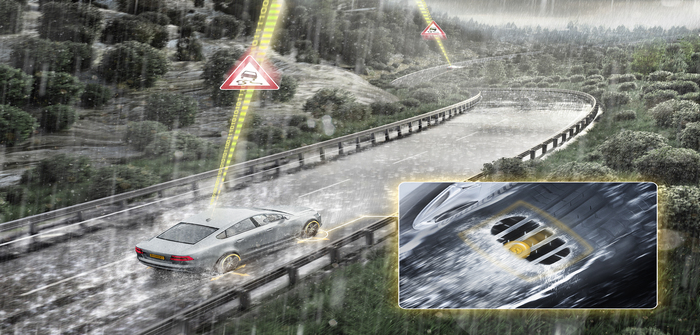Continental is developing a sensor-based system to tackle the risk of aquaplaning for both manually driven and automated vehicles. It would warn drivers of imminent loss of friction between the tire and the road, caused by a thick layer of water on the road. If the front wheels float, braking and steering are compromised.
“Wet road conditions are difficult for a car driver to evaluate,” said Bernd Hartmann, head of enhanced ADAS and tire interactions within the Advanced Technology department of Continental’s Chassis & Safety division. “Once you feel your vehicle floating, it is too late. Our aquaplaning assistance concepts detect the early aquaplaning phase to make the driver aware of what is going on under the tires. This can help drivers or automated vehicles to adapt their speed appropriately to wet road conditions.”
The system under development encompasses tires, tire sensors, cameras, algorithms, brake actuation and the human-machine interface.
Continental’s developers are focused on predicting and managing the risk of aquaplaning. The objective is to detect a possible front-wheels floating situation as early as possible, to trigger an early warning to the driver. Utilising signals from surround-view cameras and tire-mounted electronic Tire Information System (eTIS) sensors, an early warning concerning the approaching aquaplaning situation is provided to the driver. Continental is also working on the control and stabilisation of vehicles in aquaplaning situations.
Aquaplaning conditions can also occur unexpectedly with no opportunity for advance warning. In such cases, the potential risk to other vehicles on the road can be mitigated by early communication via V2X and eHorizon.
To detect aquaplaning situations, video images from surround-view cameras mounted in the side mirrors, the grill and rear are analysed. “When there is a lot of water on the road, the camera images show a specific splash and spray pattern from the tires that can be detected as aquaplaning in its early phase,” said Hartmann. For example, excessive water displacement in all directions underneath the tire is a characteristic attribute. Continental says that during the first testing phase of the new solution, the wetness recognition algorithms delivered a very high hit ratio in predicting aquaplaning conditions.
Continental also uses information from tires to detect the risk of aquaplaning. Signals from the eTIS sensors, mounted on the tire’s innerliner, are computed. “We use the accelerometer signal from the eTIS to look for a specific signal pattern,” said Andreas Wolf, head of Continental’s Body & Security business unit.
A tire model processes the incoming radial acceleration of the part of the tire that is in contact with the road. For wet roads when enough water is transported out of the tire tread to ensure an appropriate grip the signal shows a distinct pattern. As soon as a wedge of water begins to form in front of the tire footprint region and there is excessive water on the road, the acceleration signal begins to oscillate in a characteristic way, indicating an early risk of aquaplaning. Since the eTIS sensors can also detect the remaining tire tread depth, a safe speed for a given wet road condition can be calculated and communicated to the driver.
Continental says testing has shown that future aquaplaning assistance will also have the potential to intervene in an actual aquaplaning situation by applying the rear brakes in a controlled way to establish a degree of torque vectoring, to maintain vehicle manoeuvrability within physical limits.
It is difficult to pin down how many country road and highway accidents in wet road conditions are caused by floating front wheels. “This is one of the last white spots on the strategic map towards greater road safety,” said Hartmann.
But the company says drivers must continue to adjust their speed to wet roads and keep an eye on tire tread depth. Continental recommends renewing summer tires with 3mm of residual tread depth, and says below this limit, the risk of aquaplaning increases significantly.


